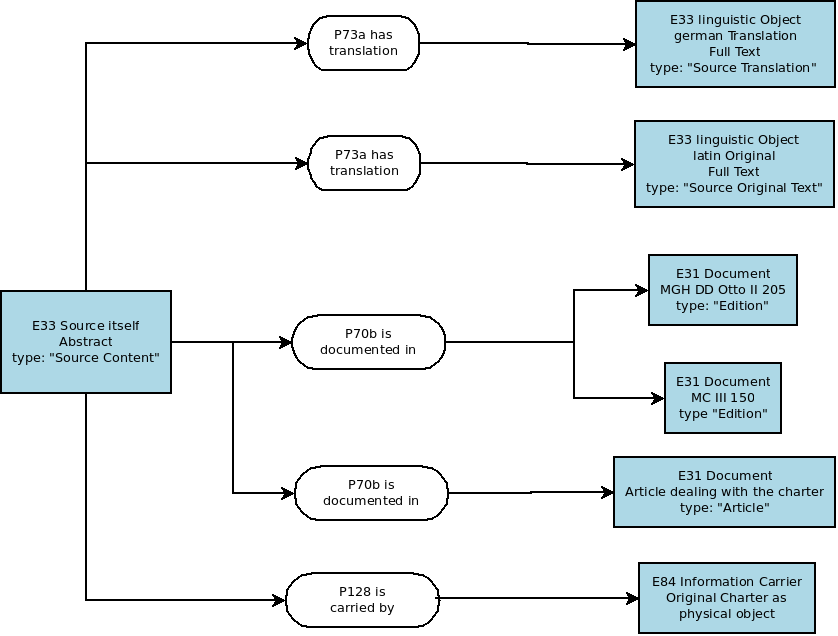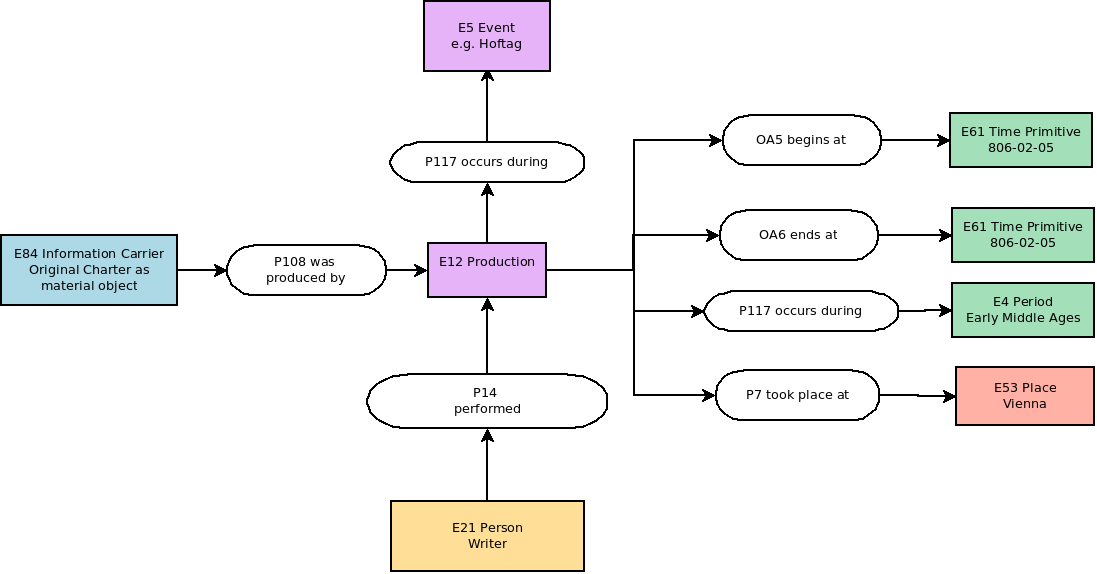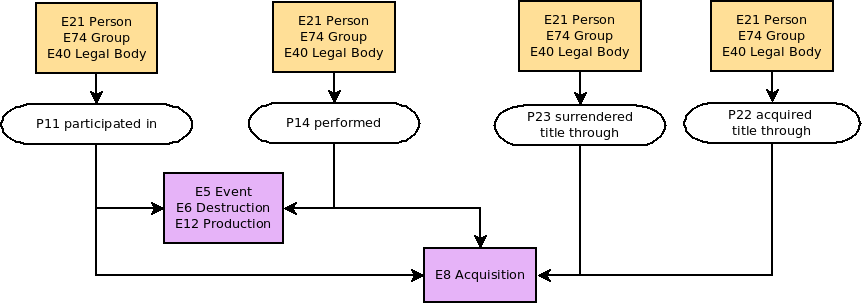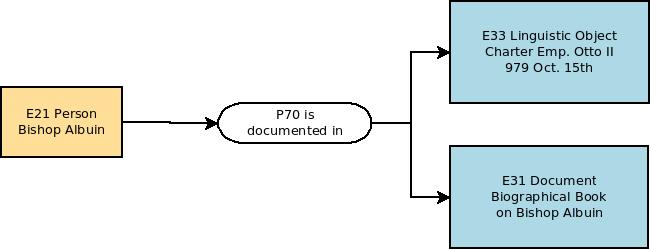
In the following section some mapping examples are discussed. Please be aware of the fact, that they may vary from the current development version of OpenAtlas.
In this section various data-mappings, as used in OpenAtlas, are presented. They use Classes and Properites from the CIDOC CRM (http://www.cidoc-crm.org/) to map the information. If custom properties or shortcuts are used they are named "OA" with a certain number. They are described in detail in the Custom Properties and Shortcuts section. Within OpenAtlas it is also possible to specify various additional attributes a property can have. E.g. the timespan in which this property links two entities or for example the role an actor has within a certain group.
Every entity recorded in OpenAtlas can have a main name respectively a primary identifier, that is stored via P1 ("is identified by" or sub-property) from the entity to E41 ("Appelation" or sub-class). This name or identifier can consist of one ore more words and can contain - e.g. in case of an actor - a first name, second name and surname as well as additional informations like titles: "Sir Elton Hercules John".
If an entity has alternative names like stagenames or pseudonyms they are also documented using a P1 (is identified by) linked to E41 (Appelation): "Reginald Kenneth Dwight" (=Birthname of Elton John). Another example would be "Charlemagne", "Carolus Magnus" and "Karl der Große" that are recorded with the described properties.
Alternative forms of names are mapped with P139: Two E42 identifier entities linked via P139 (has alternative form).

Written sources like for example medieval charters are mapped in OpenAtlas as a combination of several entities. The core is the content of the source that is defined as E33 (linguistic object).
This core usually contains a summary or the whole text of the source in a language understandable for the current users of the database. This core can be linked to translations respectively to the text in the original language (e.g. Latin) that is also stored as E33 (linguistic object).
The core can also be linked to a physical object (E84 Information Carrier) like the original charter (e.g. a parchment manuscript) that carries the information described in the core.
The core content of course can also be documented in other documents (E31) like for example various editions of charters or also secondary source.

This core of the source, respectively the source's content delivers information on various other things like the events, persons and physical things mentioned in the text. These relations are recorded with a P70b (is documented in) link from the mentioned entity to the source.

Information on the environment in which the source originally was generated or on the current or former owner is connected to the physical object/information carrier. This includes for example the legal body or the actor for whom a charter originally was signed or the archive where it is or was stored. Also time and place of creation, as well as the creator and the context of the creation can be stored.
The actor for whom the document was originally set up is recorded by a link P105 (right held by) from the information carrier (E84) to the actor.
The current or former owner of the document, e.g. the archive where a charter is currently kept, is recorded by a link P46 (has former or current owner) from the information carrier (E84) to the actor,

The production of the charter is recorded by an E12 (Production) event that is linked to the charter (E84 information carrier) with a P108 (was produced by) link.
This E12 Prodcution can be linked to places (P7 took place at) and to a certain point in time (OA5 and OA6 begins/ends at).
It can also be linked to other temporal entities, like a superior event during which the charter was produced (e.g. a Hoftag/Assembly) or to a certain chronological period/timespan via a P117 (occurs during) link.
The creator/writer (E39 Actor) of the charter is linked to the production event via a P104 (performs) property.

Within OpenAtlas single Persons (E21), Groups (E74) – like families – and legal bodies (E40) like for example the Holy Roman Empire are dealt with.
They can be linked to other entites like actors, events, documents, physical things, places, date and time etc.
Actors can participate in Events either actively or passively. The first case is mapped with P14 performed, the latter with P11 participated in. In case of changes of property (i.e. if the event is a E8 Acquisition) P23 surrendered title through - for the giver - and P22 acquired title through -for the receiver - are used.

Also the actor's role can be documented by linking the property with a E55 type entity: For example to map an actor's role as sponsor and another one's role as artist/creator during the creation of a physical man made thing.

Actors (like any other entities) can be linked to E73 Information Objects like E31 Document e.g. an article on a historical person or E33 linguistic objects like the text of a medieval charter in which a person is mentionend.

Actors can be part of or have a certain role within a E74 group or a E40 legal body. The specification of this "membership" is recorded with a link to a E55 type

Actors can have direct relationships to other actors. Such relations are mapped with OA7 has relationship to. The type of relationship is specified with a link to E55 type.
Such relationships can be the same in both directions (E.g. Person A is friend of Person B and at the same time Person B is friend of Person A) or have an opposite meaning in the opposite direction (E.g. Person A is the father of person B while Person B is the son of Person A).

Actors can have direct relationships to Physical Things. In most cases this regards property which means that for example a person is the owner of a thing, like e.g. a manor. Such relations are mapped with P51i is former of current owner of.

Actors can have various direct relations to places. Next to them they may participate at an event that takes place a a certain location (see: Actors and Events
Actors can have a certain prefered place like a residence, a headquarter etc. E.g. Salzburg (E53 place) is the headquarter of the Salzburg Bishopric (E40 legal body) Such relations are mapped with P74 has current or former residence.

Actors can have a certain place in which they are born (or appear for the firs time) as well as a place of death (or a place where they appear for the last time). Such relations are mapped with OA8 appears for the first time in and OA9 appears for the last time in.

Actors can have a date at which they were born (or appear for the first time) or die (respectively appear for the last time). Such relations are mapped with OA1 begins chronologically and OA2 ends chronologically (to mark the timespan or date in/on which they appear for the first time) or OA3 born_chronologically and OA4 dies_chronologically (to mark a date on which they where born or died - if known). They link an actor with a time primitive like a timestamp.

In case this date is not known exactly, two time primitives can be recorded to mark a certain temporal span in which the birth or the first resp. death or last appearance took place. The first timestamp therefore is connected (p2 has type) with a type (E52) "from value", the second with a "to value" type (=Subtypes of "Numeric Value Types"). If one exact date is known this one gets the type "exact value".
These shortcuts are used in OpenAtlas to link various entities for certain purposes:
OA1 is used to link the beginning of a persistent item's (E77) life span (or time of usage) with a certain date in time.
E77 Persistent Item linked with a E61 Time Primitive:E77 (Persistent Item) - P92i (was brought into existence by) - E63 (Beginning of Existence) - P4 (has time span) - E52 (Time Span) - P81 (ongoing throughout) - E61 (Time Primitive)
Example: [Holy Lance (E22)] was brought into existence by [forging of Holy Lance (E12)] has time span [Moment/Duration of Forging of Holy Lance (E52)] ongoing througout [0770-12-24 (E61)]
OA2 is used to link the end of a persistent item's (E77) life span (or time of usage) with a certain date in time.
E77 Persistent Item linked with a E61 Time Primitive:E77 (Persistent Item) - P93i (was taken out of existence by) - E64 (End of Existence) - P4 (has time span) - E52 (Time Span) - P81 (ongoing throughout) - E61 (Time Primitive)
Example: [The one ring (E22)] was destroyed by [Destruction of the one ring (E12)] has time span [Moment of throwing it down the lava (E52)] ongoing througout [3019-03-25 (E61)]
OA3 is used to link the birth of a person with a certain date in time.
E21 Person's Birth linked with a E61 Time Primitive:E21 (Person) - P98i (was born) by - E67 (Birth) - P4 (has time span) - E52 (Time Span) - P81 (ongoing throughout) - E61 (Time Primitive)
Example: [Stefan (E21)] was born by [birth of Stefan (E12)] has time span [Moment/Duration of Stefan's birth (E52)] ongoing througout [1981-11-23 (E61)]
OA4 is used to link the death of a person with a certain date in time.
E21 Person's Death linked with a E61 Time Primitive:E21 (Person) - P100i (died in) - E69 (Death) - P4 (has time span) - E52 (Time Span) - P81 (ongoing throughout) - E61 (Time Primitive)
Example: [Lady Diana (E21)] died in [death of Diana (E69)] has time span [Moment/Duration of Diana's death (E52)] ongoing througout [1997-08-31 (E61)]
OA5 is used to link the beginning of a temporal entity (E2) with a certain date in time. It can also be used to determine the beginning of a property's duration.
E2 Temporal Entity linked with a E61 Time Primitive:E2 (Temporal Entity) - P4 (has time span) - E52 (Time Span) - P81 (ongoing throughout) - E61 (Time Primitive)
Example: [ Thirty Years' War (E7)] has time span [Moment/Duration of Beginning of Thirty Years' War (E52)] ongoing througout [1618-05-23 (E61)]
OA6 is used to link the end of a temporal entity's (E2) with a certain date in time. It can also be used to determine the end of a property's duration.
E2 temporal entity linked with a E61 Time Primitive:E2 (temporal entity) - P4 (has time span) - E52 (Time Span) - P81 (ongoing throughout) - E61 (Time Primitive)
Example: [ Thirty Years' War (E7)] has time span [Moment/Duration of End of Thirty Years' War (E52)] ongoing througout [1648-10-24 (E61)]
OA7 is used to link two Actors (E39) via a certain relationship
E39 Actor linked with E39 ActorE39 (Actor) - P11i (participated in) - E5 (Event) - P11 (had participant) - E39 (Actor)
Example: [ Stefan (E21)] participated in [ Relationship from Stefan to Joachim (E5)] had participant [Joachim (E21)]
The connecting event is defined by an entity of class E55 (Type):
[Relationship from Stefan to Joachim (E5)] has type [Son to Father (E55)]
OA8 is used to link the beginning of a persistent item's (E77) life span (or time of usage) with a certain place. E.g to document the birthplace of a person.
E77 Persistent Item linked with a E53 Place:E77 (Persistent Item) - P92i (was brought into existence by) - E63 (Beginning of Existence) - P7 (took place at) - E53 (Place)
Example: [Albert Einstein (E21)] was brought into existence by [Birth of Albert Einstein (E12)] took place at [Ulm (E53)]
OA9 is used to link the end of a persistent item's (E77) life span (or time of usage) with a certain place. E.g to document a person's place of death.
E77 Persistent Item linked with a E53 Place:E77 (Persistent Item) - P93i (was taken out of existence by) - E64 (End of Existence) - P7 (took place at) - E53 (Place)
Example: [Albert Einstein (E21)] was taken out of by [Death of Albert Einstein (E12)] took place at [Princeton (E53)]
E77 (Persistent Item) - P8 (witnessed) - E5 (its own Creation or Modification) - P117 (occurs during) - E4 (period)
Example: [Church of Notre Dame (E18)] belongs stylistically to [Gothic Period (E4)]
E77 (Persistent Item) - P93i (was taken out of existence by) - E64 (end of Existence) - P4 (has time span) - E52 (Time Span)
Example: [The one ring (E22)] was destroyed by [Destruction of the one ring (E12)] has time span [Late Third Age (E52)]
E77 (Persistent Item) - P92i (was brought into existence by) - E63 (Beginning of Existence) - P4 - E52 (Timespan)
Example: [Holy Lance (E22)] was brought into existence by [forging of Holy Lance (E12)] has time span [Carolingian Period (E52)]
In our model it is possible to link from E1 with P2 to E59